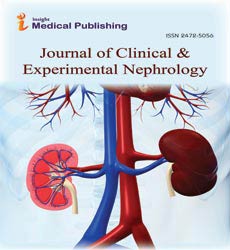Acute Tubular Necrosis and its Outcomes
Qing Xu*
Department of Science, Nanyang Bussiness school NTU, South China University of Technology, China
- *Corresponding Author:
- Qing Xu
Department of Science,
Nanyang Bussiness school NTU, South China University of Technology,
China;
E-mail: QingXu@yahoo.cn
Received: February 18, 2022, Manuscript No. IPJCEN-22-11498; Editor assigned: February 21, 2022, PreQC No. IPJCEN-22-11498 (PQ); Reviewed: March 07, 2022, QC No. IPJCEN-22-11498; Revised: March 11, 2022, Manuscript No. IPJCEN-22-11498 (R); Published: March 18, 2022, Invoice No. IPJCEN-22-11498
Citation: Xu Q (2022) Acute Tubular Necrosis and its Outcomes. J Clin Exp Nephrol Vol:7 No:1
Editorial
The shortage of kidney allografts combined with the difficulties of performing multicenter perished contributor research is key snags in transplantation. The allograft deficiency delays holding up list times, bringing about decays in wellbeing and personal satisfaction for patients kept up with on persistent dialysis. To extend organ supplies, we progressively use kidneys from expired givers with hazard factors for allograft brokenness. To resolve these issues, the transfer local area needs successful instruments to survey early injury and forecast. Such apparatuses could work with the distribution of reasonable kidneys, lead to novel treatments for early allograft injury, and further develop beneficiary results.
After gift, all relocated organs go through ischemia followed by reperfusion in the beneficiary. Indeed, even before acquirement, notwithstanding, a giver might encounter organ ischemia during the essential affront prompting passing. These affronts can prompt renal injury that might be clinically and additionally histologically measured. A developing assortment of writing in nontransplant settings proposes that AKI starts and spreads CKD. A few factors straightforwardly or by implication identified with AKI have been assessed in transplantation, including protection strategy, cold-ischemia time, and benefactor terminal creatinine (10), albeit many creators contend against disposing of kidneys dependent on high creatinine levels alone. Histopathologic assessment can be viewed as the highest quality level for distinguishing underlying AKI. A superior comprehension of how intense primary kidney injury is presently evaluated by contributor biopsy and answered to imminent transfer habitats might give new experiences about choices in regards to organ allotment, dispose of/refusal, and protection choices. The OPOs (organ acquirement associations) performed wedge biopsies following acquisition, and distinctive pathology administrations related with these OPOs assessed frozen areas to produce reports for survey by potential transfer habitats. The OPOs performed wedge biopsies following acquirement, and diverse pathology administrations related with these OPOs assessed frozen segments to produce reports for audit by potential transfer places.
On the off chance that no portrayal of seriousness or rounded contribution was given, we classified the ATN as moderate. All accessible sequential contributor biopsy reports from relocated kidneys were incorporated and connected to beneficiaries through the United Network for Organ Sharing (UNOS) information base. OPOs additionally gave the accompanying contributor/allograft data and attributes (not accessible from UNOS) to test as expected confounders: affirmation creatinine, terminal pee yield, utilization of any vasoactive prescriptions (dopamine, epinephrine, norepinephrine, phenylephrine, arginine vasopressin, dobutamine, or sodium nitroprusside) inside 24 hours of acquisition, and machine perfusion qualities (perfusate stream and renal opposition) at 4 hours for kidneys that were saved with machine perfusion.
This multicenter study is the biggest accomplice to date to analyze relationship between detailed AKI by preimplant histology and allograft results. We showed that preimplant biopsy-announced ATN, as given real organ offers, is unassumingly connected with the advancement of DGF just in DCD kidneys. All the more by and large, nonetheless, our discoveries propose that these ATN reports give minimal utility to deciding the general danger of DGF or unexpected passing controlled join disappointment in expired giver kidney transplantation.
Thinking about the basically adverse consequences of this review, it is sensible to address whether ATN, or AKI overall so far as that is concerned, really causes significant allograft results. Preimplant ATN can just reflect one part of the injury in question (i.e., ischemic injury) and can't catch the commitment from beneficiary reperfusion. Due to the time intrinsic in dispensing and moving a perished giver kidney, some level of ischemic primary injury might be unavoidable, which might be much more extreme in DCD settings given longer times of warm ischemia before the kidney can be flushed and acquired. This irregularity might be identified with DCD acknowledgment designs, in that DCD kidneys acknowledged for relocate and remembered for most accomplice concentrates in any case will in general be of moderately excellent. Proof for this differential contributor quality can be seen by the lower terminal creatinines in our DCD kidneys contrasted and non-DCD kidneys.
Albeit different techniques exist for evaluating kidney injury at acquirement, the current discoveries are essential to transplantation on the grounds that histopathology can be viewed as the highest quality level measure for this danger factor. As recently noted, notwithstanding, the nature of presently used preimplant biopsies for distinguishing intense injury might be restricted for quite a long time. Hence, histologic ATN can be neglected by and large, and our information in regards to fluctuation in ATN revealing between OPOs just as misclassification dependent on a manual survey of few biopsies from one OPO give solid proof to this. To address this possible predisposition, we played out an affectability examination where we barred all kidneys from the one OPO without any reports of ATN, which didn't influence our review decisions.
Open Access Journals
- Aquaculture & Veterinary Science
- Chemistry & Chemical Sciences
- Clinical Sciences
- Engineering
- General Science
- Genetics & Molecular Biology
- Health Care & Nursing
- Immunology & Microbiology
- Materials Science
- Mathematics & Physics
- Medical Sciences
- Neurology & Psychiatry
- Oncology & Cancer Science
- Pharmaceutical Sciences
